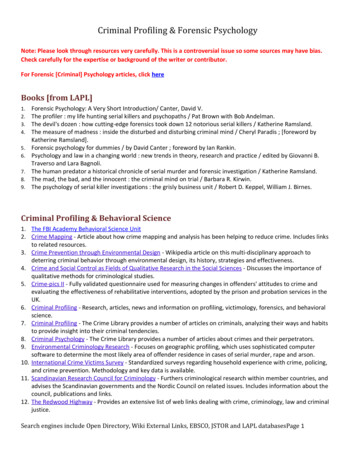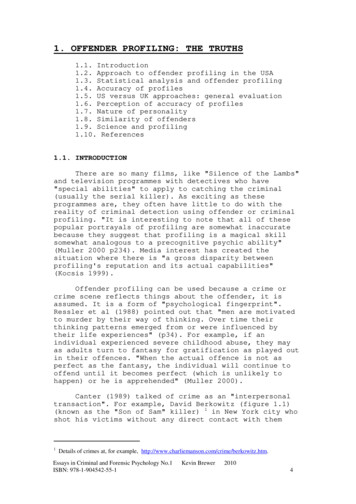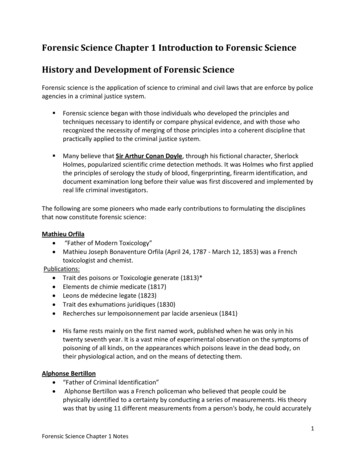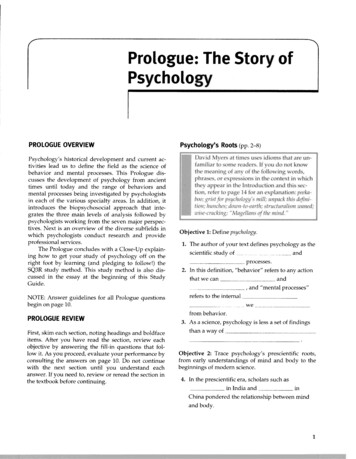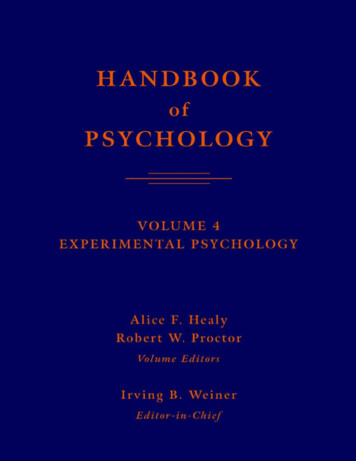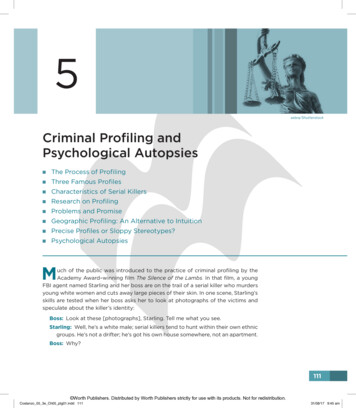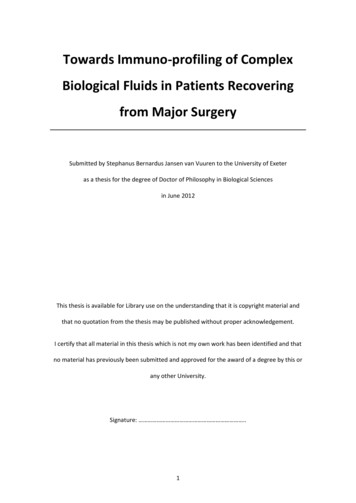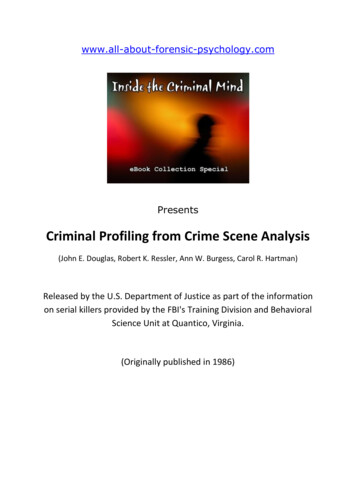
Transcription
Forensic Psychology andProfiling
Which one is the serial killer?
Karla Homolka With the aid of her husband, rapes andkills first her sister, then three other girls.Attempts to blame her sexual predation on“battered wife syndrome”However: it is subsequently revealed thatshe is an equal partner in the murders.Most people believe that almost all violentoffenders are male, when in fact womenmake up a sizable percentage (based ontype of crime--15% overall, about 50% ofintimates)
Early Biological Theories
Cesare Lombroso: 1876 Argued that the criminal isa separate species, aspecies that is betweenmodern and primitivehumans.He argued that thephysical shape of the headand face determined the"born criminal".
Lombroso studied and measured the bodies ofexecuted and deceased offenders as well asexamining living inmates to locate physicaldifferences or abnormalities.Claimed to have found a variety of bodilyfeatures predictive of criminal behavior. Long arms, large teeth, ears lacking lobes, lots ofbody hair.Also identified characteristics of particular types ofoffenders.
William Sheldon: 1898 Hesaid people could be classified into threebody shapes, which correspond with threedifferent personality types.\
Body Types: Endomorphic (fat and soft) tend to be sociableand relaxed.Ectomorphic (thin and fragile) are introverted andrestrained.Mesomorphic (muscular and hard) tend to beaggressive and adventurous.Sheldon found (in a study) that many convicts weremesomorphic, and they were least likely to beectomorphic.
Endomorph, Mesomorph, Ectomorph,
We have culture that is obsessed withcriminals and those who catch them:
Mass Murder Generally described as a number of murders (four or more)occurring during the same incident, with no distinctivetime period between the murders. These events typicallyinvolved a single location, where the killer murdered anumber of victims in an ongoing incident.
Spree MurderThe general definition is twoor more murders committedby an offender or offenders,without a cooling-off period. The factors included in thedefinition of serial murderinclude:– One or more offenders.– Two or more murderedvictims– Incidents should be occurringin separate events, atdifferent times, but with shortintervals between.
Serial Murder The unlawful killing of two or more victimsby the same offender(s), in separate eventswith a cool down period.
Criminal Profiling is: The process ofidentifying:– personality traits,– behavioral tendencies,To assess whether they arelikely to have committed acrime under investigation.
Goals of Profiling The primary goal ofprofiling is to narrow thefield of possible suspects. Profiling is also a form ofprediction -- the profilertries to “predict” who theoffender or offenders mightbe and where and how thenext crime may occur.
The Nitty Gritty of
The Organized-Disorganized TypologyThe FBI Model Whether the crimescene is leftORGANIZED orDISORGANIZED issaid to provideinformation aboutthe offender’scriminalsophistication andpersonality.
An Organized crime scene reflects: An offender who commits crime out of aneed for power.
The Organized Crime Scene Offense plannedVictim a targeted strangerVictim personalizedControlled conversationCrime scene reflectsoverall control Demands submissivevictim Restraints used Aggressive acts prior todeath Body hidden Weapon/evidence absent victim or bodytransported from scene Associated withpsychopathy
A Disorganized crime scene reflects: An offender who commits crime out ofpassion, compulsion, frustration, or anxiety.
The Disorganized Crime Scene Spontaneous offenseVictim or location knownDepersonalizes victimMinimal conversationCrime scene random andsloppy Sudden violence to victim Minimal use of restraintsSexual acts after deathBody left in viewEvidence/weapon oftenpresent Body left at death scene Associated with Psychosis
Organized Killers: Dexter Ted Bundy BTK Jeffery Dahmer
Disorganized Killers: Ed Gein “Son of Sam” DavidBerkowitz
What is the difference between a Psychopath and Sociopath?
Do They Have a Conscience?A key difference between a psychopath and a sociopath is whetherhe/she has a conscience, the little voice inside that lets us know whenwe’re doing something wrongFor example:A psychopath doesn’t have a conscience. If he lies to you so he cansteal your money, he won’t feel any moral guilt, though he maypretend to. He may observe others and then act the way they do so he’snot “found out,”A sociopath typically has a conscience, but it’s weak. He may knowthat taking your money is wrong, and he might feel some guilt orremorse, but that won’t stop his behavior.
Both lack empathy, the ability to stand in someone else’s shoes andunderstand how they feel. A psychopath has less regard for others,Someone with this personality type sees others as objects he can use forhis own benefit.
Staging – Altering the crime scene to throw theinvestigation, this may happen withorganized offenders.11
An important aspect is an analysis of crime scene staging,in an attempt to confuse or misdirect law enforcementinvestigators from the true cause of death or motive for thekilling. Many serial killers are more likely to stage murder thescenes precisely to shock and/or taunt police & the media. Thus, when examining a murder scene, be sure to considerwho would benefit from the scene being staged as it is.
Victimology Many serial killers tend tospecialize in specific typesof victims. One keyaspect of developing aprofile is an understandingof the killer’s victim(s). Sometimes the only wayto get a handle on thecauses and circumstancesof the homicide is todevelop a thoroughunderstanding of thevictim.
Victim Data Collection Look for the victim’s wallet or some other formof identification. An accurate description of clothing and any otherpersonal effects at the scene is also essential. Try to obtain viable fingerprints. Photograph the victim. The medical examiner will document anydistinguishing features, marks, scars, tattoos,piercings, etc. during autopsy. Use this information to check against anyMissing Person Reports.
Family and friends:Interviewing thesecollaterals is important for two reasons. 1. First. violence, including murder,mostly occurs between people who know each other! 2. Second, the victim may have confided in closefriends or relatives and this may give investigators aclue to her whereabouts shortly before she waskilled.
Criminal Profiling is: The process of identifying: – personality traits, – behavioral tendencies, To assess whether they are likely to have committed a crime under investigation. Goals of Profiling. The primary goal of profiling is to narrow the field of possible suspects.

